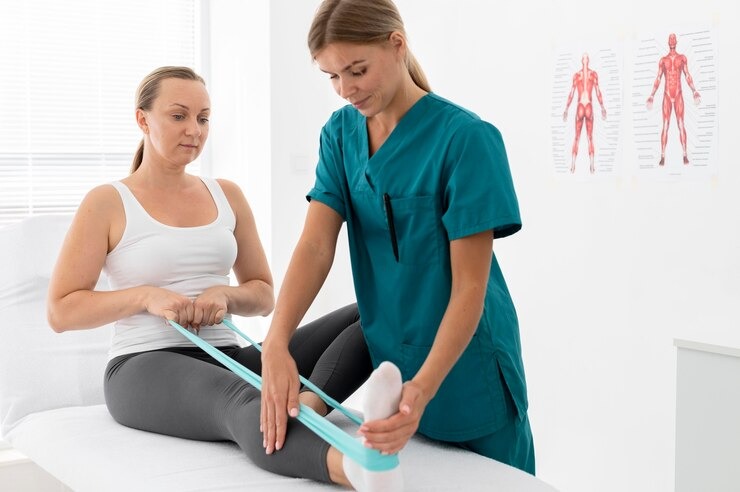11 Types of Physical Therapy You Must Know
What is Physical therapy?
Physical therapy, also known as physiotherapy, is a healthcare profession that focuses on the diagnosis, treatment, and prevention of physical impairments, disabilities, and movement disorders. It involves the use of various techniques and exercises to improve a patient's physical function and quality of life. Physical therapists (PTs) are licensed professionals who work with individuals of all ages, from infants to the elderly, in a variety of settings, including hospitals, clinics, private practices, schools, and sports facilities.

Why do we need Physical Therapy?
Physical therapy is essential for maintaining and improving overall health, recovery, and quality of life. It helps individuals manage pain, enhance mobility, and recover from injuries or surgeries. By addressing specific physical limitations, physical therapy aids in the prevention of future injuries and the management of chronic conditions. Additionally, it provides vital support for those with neurological conditions, ensuring better functional outcomes and independence.
• Pain Management: Reduces or eliminates the need for pain medications.
• Mobility Improvement: Enhances range of motion, flexibility, and overall movement.
• Injury and Surgery Recovery: Facilitates faster and more effective rehabilitation.
• Chronic Condition Management: Helps manage symptoms and improve quality of life.
• Fall Prevention: Improves balance and stability, reducing the risk of falls.
Different Types of Physical Therapy
Physical therapy encompasses a variety of specialized fields, each targeting specific health issues and patient needs. Here are 11 different types of physical therapy:
Neurological Therapy: Neurological therapy, or neurological physical therapy, rehabilitates individuals with conditions like stroke, spinal cord injuries, multiple sclerosis, and Parkinson's disease. It enhances motor control, strength, and mobility through targeted exercises, balance training, and advanced technologies, helping patients regain independence and improve physical function.
Orthopedic Therapy: Orthopedic therapy focuses on treating musculoskeletal issues such as injuries to muscles, bones, ligaments, and tendons. It involves exercises, manual therapy, and modalities to reduce pain, improve function, and enhance mobility. This therapy helps patients recover from injuries, surgeries, and chronic conditions, promoting overall physical health and independence.
Cardiovascular Therapy: Cardiovascular therapy focuses on improving heart and lung health through exercise and lifestyle changes. It helps patients recover from heart attacks, manage chronic conditions like COPD, and enhance overall cardiovascular function, promoting better endurance and quality of life.
Clinical Electrophysiology Therapy: Clinical Electrophysiology Therapy involves the diagnosis and treatment of heart rhythm disorders using advanced technology and techniques. It encompasses procedures such as electrophysiology studies and ablation therapy to correct irregular heart rhythms. By precisely targeting abnormal electrical pathways in the heart, this therapy aims to restore normal heart function and improve patient outcomes.
Integumentary Therapy: Integumentary Therapy focuses on the health and healing of the skin, hair, and nails. It involves various treatments aimed at addressing dermatological conditions, wounds, and injuries. Through techniques such as topical medications, dressings, and specialized procedures, integumentary therapy aims to promote skin regeneration, manage infections, and enhance overall skin health.
Sports Physical Therapy: Sports Physical Therapy specializes in the rehabilitation and prevention of injuries related to sports and exercise. It employs tailored exercise programs, manual therapy techniques, and modalities to optimize athletes' performance and recovery. By addressing biomechanical imbalances, enhancing strength and flexibility, and promoting proper movement patterns, sports physical therapy helps athletes return to their activities safely and effectively.
Geriatric Therapy: Geriatric Therapy focuses on addressing the unique physical, cognitive, and emotional needs of older adults. It encompasses a range of interventions aimed at improving mobility, strength, balance, and overall quality of life in elderly individuals. Through personalized exercise programs, cognitive interventions, and adaptive strategies, geriatric therapy aims to promote independence, prevent falls, manage chronic conditions, and enhance social engagement in aging populations.
Pediatric Physical Therapy: Pediatric Physical Therapy aids children in enhancing their motor skills and movement abilities through tailored exercises and playful interventions. By focusing on individual needs and developmental stages, it facilitates optimal physical development, enabling children to engage fully in daily activities and reach their potential.
Pulmonary Therapy: Pulmonary Therapy targets respiratory issues, aiming to improve lung function and overall breathing capacity. Through techniques such as breathing exercises, airway clearance methods, and pulmonary rehabilitation programs, it helps individuals with conditions like COPD, asthma, and cystic fibrosis to manage symptoms and enhance quality of life.
Shockwave Therapy: Shockwave Therapy employs high-energy acoustic waves to treat various musculoskeletal conditions, such as tendonitis and plantar fasciitis. These waves stimulate the body's natural healing processes, promoting tissue regeneration and pain relief. With its non-invasive approach and proven efficacy, shockwave therapy offers a promising option for managing chronic pain and enhancing mobility.
Acupressure Therapy: Acupressure Therapy involves applying pressure to specific points on the body to promote relaxation, alleviate pain, and enhance overall well-being. Based on the principles of traditional Chinese medicine, it aims to restore the body's balance of energy, or qi. By stimulating these points, acupressure therapy can help relieve stress, improve circulation, and reduce tension in muscles and joints.
In summary, physical therapy offers a broad spectrum of specialized interventions, from pediatric to geriatric, and innovative methods such as shockwave and acupressure therapy. These modalities target specific needs, enhancing mobility, managing pain, and promoting overall well-being. Through evidence-based practices, physical therapists play a key role in guiding individuals towards improved health and functionality.
